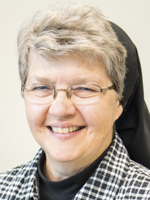
I was in seventh grade when I noticed an acceleration in Sister Eymard’s cautions to us about the importance of being Mary-like.
I just knew that she had gotten wind of the recent addition of spin-the-bottle to our offsite birthday celebrations. Maybe she had even used her X-ray vision to see through the folds of the notes James Y and I were exchanging about where to meet: the coat room where the pencil sharpener was, the stairway running from the choir loft to the church basement, the Strand Theater?
The idea of being Mary-like sounded syrupy, well-behaved, and dull. Statues always made her look as if she spent her life gazing upward and saying the rosary (to herself? I wondered).
Fortunately, some decades have passed since seventh grade, and my faith and insights have had a chance to mature a bit. There are powerful scriptural, contemplative, and peace-loving reasons why I pray the rosary daily. I now understand why Mary matters so much.
There’s a line in the Book of Wisdom about friends of God and prophets. I have come to understand that the Blessed Virgin is foremost among them. Her intimacy with the Holy Trinity exceeds that which any other human being has attained.
Ancient traditions and visions, like those of Juan Diego and the children of Fatima, reveal that she maintains a maternal love for the whole global population and intercedes for the well-being of all the earth. The name of the shrine basilica in Orlando is no exaggeration: Queen of the Universe. And it is no mistake that it is placed smack-dab in the middle of Disney and Universal, and also the site of the Pulse massacres.
Mary was a gutsy lady. It took fortitude to accept an inexplicable and potentially life-threatening pregnancy in order to fulfill messianic prophecy. It took stubborn dedication to flee the early Herod and to try, much later, to rescue her son when his preaching and healing started to look too risky.
It took hard swallowing to deal with a wondrous 12-year-old abandoning a caravan to dialogue with rabbis and two-plus decades later to watch scribes and Pharisees conspire with Rome to crucify him. It took ageless wisdom for her to instruct stewards at Cana to “Do what he tells you” and then to wait for God-knows-what in the upper room with trembling disciples after the crucifixion and Easter.
The Blessed Lady knew triumph and tragedy. She observed the Law and defied convention. She was full of grace and engaged in the nitty-gritty of straw-strewn stables, sawdust-riddled carpentry shops, and the dread clank of the armor of red-clad roughnecks.
It is no accident that three of the most courageous recent saints had deep devotion to her: Maximilian Kolbe, Teresa of Kolkata, and John Paul II. They grasped that consecration to Mary takes strenuous effort. Discerning and doing God’s will is grunge work. Displacing self-interest with dedication to the good of others takes heroism.
Being Mary-like is not for wimps.
Sister Pamela Smith, SSCM, is the Secretary for Education and Faith Formation at the Diocese of Charleston. Email her at psmith@catholic-doc.org.
Image: Detail, Coronation of the Virgin; Raphael, 1502-1504



